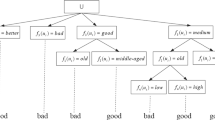Abstract
Multivariate data modelling problems consist of a number of nodes with associated function (class) values. The main purpose of these problems is to construct an analytical model to represent the characteristics of the problem under consideration. Because the devices, tools, and/or algorithms used to collect the data may have incapabilities or limited capabilities, the data set is likely to contain unavoidable errors. That is, each component of data is reliable only within an interval which contains the data value. To this end, when an analytical structure is needed for the given data, a band structure should be determined instead of a unique structure. As the multivariance of the given data set increases, divide–and–conquer methods become important in multivariate modelling problems. HDMR based methods allow us to partition the given multivariate data into less variate data sets to reduce the complexity of the given problem. This paper focuses on Interval Factorized HDMR method developed to determine an approximate band structure for a given multivariate data modelling problem having uncertainties on its nodes and function values.
Similar content being viewed by others
References
Banerjee, I., Ierapetritou, M.G.: Model independent parametric decision making. Ann. Oper. Res. 132(1–4), 135–155 (2004)
Chowdhury, R., Rao, B.N.: Hybrid high dimensional model representation for reliability analysis. Comput. Methods Appl. Mech. Eng. 198, 753–765 (2009)
Gomez, M.C., Tchijov, V., Leon, F., Aguilar, A.: A tool to improve the execution time of air quality models. Environ. Model. Softw. 23, 27–34 (2008)
Oevel, W., Postel, F., Wehmeier, S., Gerhard, J.: The MuPAD Tutorial. Springer, New York (2000)
Rabitz, H., Alış, Ö.F.: General foundations of high dimensional model representations. J. Math. Chem. 25, 197–233 (1999)
Sobol, I.M.: Sensitivity estimates for nonlinear mathematical models. Math. Model. Comput. Exper. 1, 407–414 (1993)
Tunga, M.A., Demiralp, M.: Data partitioning via generalized high dimensional model representation (ghdmr) and multivariate interpolative applications. Math. Res. 9, 447–462 (2003)
Tunga, M.A., Demiralp, M.: A factorized high dimensional model representation on the nodes of a finite hyperprismatic regular grid. Appl. Math. Comput. 164, 865–883 (2005)
Tunga, M.A., Demiralp, M.: A new approach for data partitioning through high dimensional model representation. Int. J. Comput. Math. 85(12), 1779–1792 (2008)
Tunga, M.A., Demiralp, M.: Bound analysis in univariately truncated generalized high dimensional model representation for random-data partitioning: interval ghdmr. Appl. Numer. Math. 59, 1431–1448 (2009)
Ziehn, T., Tomlin, A.S.: Gui-hdmr—a software tool for global sensitivity analysis of complex models. Environ. Model. Softw. 24, 775–785 (2009)
Author information
Authors and Affiliations
Corresponding author
Rights and permissions
About this article
Cite this article
Tunga, M.A., Demiralp, M. Bound Analysis Through HDMR for Multivariate Data Modelling - CMMSE. J Math Model Algor 12, 265–276 (2013). https://doi.org/10.1007/s10852-012-9211-7
Received:
Accepted:
Published:
Issue Date:
DOI: https://doi.org/10.1007/s10852-012-9211-7




